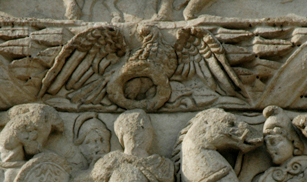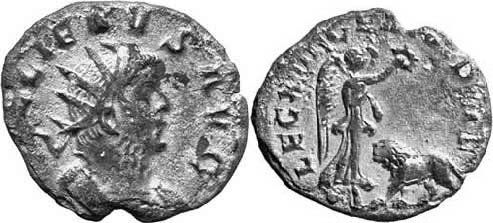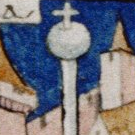
This page created 23 March 2014, and last modified: 30 October 2015 (Gallienus coin added)

The Tertiodecimani is listed (18.16 in Ingo Maier's numbering scheme) as the fifth of the legiones comitatenses under the Magister Militum per Thracias. Its shield pattern (17#6) as shown in various manuscripts, under the label (17.f) Tertio decimani, is as below:

The shield pattern has a white main field, and yellow boss encircled first by red, and outwards of this, a blue band. Some form of canid, seemingly a hound, is depicted in blue at the six o'clock position, facing left (brown in B, and also facing right, which being printed, reverses the facings of all the shields). Three other Legiones comitatenses units under the Magister Militum per Thracias, the Quartodecimani (18.17), the Constantini seniores (18.20), and the Divitenses Gallicani (18.21), have very similar patterns to that of the Tertiodecimani, as can be seen below from the following patterns taken from the Paris manuscript:

Given the seemingly unrelated nature of the names of units, this suggests a simultaneous issuance when all four were perhaps detached from their parent units to join a new formation (such as that of the Magister Militum per Thracias).
One must wonder why the Tertiodecimani alone of these four units does not feature an eagle. The image of an eagle above a central ring (which would thus surround a shield's boss) brings to mind the Arch of Galerius, where an eagle grasping a wreath of victory is shown other Galerius' (defaced) head:

The name of the unit clearly indicates the unit is a detachment of Legio XIII gemina, which had a lion as its legionary badge, and although the animal on the shield of the Tertiodecimani looks more like a dog as illustrated in the surviving copies of the Notitia, it may that the animal was depicted as being more leonine in the original compilation. Shown below is a coin of Gallienus depicting the legion's lion being crowned by Victory on its reverse.

Note that five detachments of Legio XIII gemina appear in the Notitia commanded by prefects under the Dux Daciae ripensis, each under the title "Praefectus legionis tertiaedecimae geminae"; they are stationed at Aegeta, Transdrobeta, Burgo Novo, Zernis, and Ratiaria, respectively (80.23-27); the main base had been established at Ratiaria after Aurelius withdrew from Dacia. Another detachment appear under the Comes limitis Aegypti as the Legio tertiadecima gemina, stationed at Babilona (52.3, modern Coptic Cairo).
A papyrus (P.Oxy. X 1261 (325)) mentioning the Egyptian detachment receiving 949 annonae diurnae has been interpreted as implying the detachment had a strength of 800 - 900 men, allowing for officers having multiple shares, possibly representing two old-style cohorts' worth of men. If the Thracian field army detachment was of similar size, then the five detachments remaining under the Dux Daciae ripensis would presumably have been smaller, or they would together total well over 10 cohorts' worth of men.
Interestingly, an image of the Babilona detachment's standard may have survived: the frontpiece for the Comes limitis Aegypti uniquely illustrates what may well be standards of some of the Egyptian units arising out of their station depictions. Nine such decorated poles are shown: two are clearly of the aquila (Eagle)-type, five are of the imago (Imperial portrait)-type, one's shape is hard to discern, while that shown in Babilona, and thus presumably belonging to Legio tertiadecima gemina, is rather different, as can be seen from the close-up of the image shown in the Bodleian manuscript (O) below:

This has a rather remarkable character: that of a globus cruciger (orb surmounted by a cross), as the earliest datable image I am aware of of such a globus cruciger is from a coin of Theodosius II of 423 (coins of his father Arcadius, who died in 408, show orbs surmounted by winged Victories rather than crosses). This is one of just two obviously Christian crosses shown in the Notitia (the other is also an Egyptian standard, apparently belonging to the Ala Theodosiana nuper constituta (52.8) also stationed in Egypt (a potential further candidate might be the small cross surmounting the crescent of the Matiarii iuniores; 9.24).
Egypt was more strongly Christian in the early 4th century than many other parts of the empire, and it may be the men of the Egyptian detachment were almost all Christian by the date of the Notitia's compilation; whether this extended to the Thracian Tertiodecimani, even by the close of the 4th century, is another question, however.
1. Ingo Maier; "Appendix 4: Numeration of the new edition of the compilation 'notitia dignitatum' (Cnd)"; last accessed 26 October 2015. See also for here for numbering examples. Return
2. Amin Benaissa; "The Size of the Numerus Transtigritanorum in the Fifth Century", ZPE 175 (2010) 224-226; available here (link dead as of 31 October 2015). Return

Return to the Notitia alphabetical unit list page.
Return to my Notitia index page.